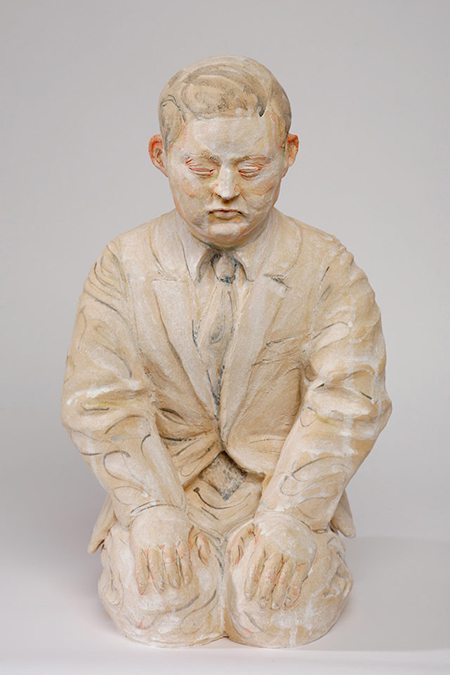
With Seattle the fastest growing city in the nation (52 people move here each day), the city's art scene is also in a state of extraordinary flux. Five exhibitions of 2017 stand out as memorable models of talent, innovation, rediscovery and promise. Before examining them, it's worth noting in passing that, despite a few galleries closing after many years (Platform and Punch), others have opened in their place (Zinc and Prographica / KDR). Art museums are also shifting staff, with new directors taking the reins at the Frye Art Museum (Joseph Rosa); Bellevue Arts Museum (Benedict Heywood); Bainbridge Island Museum of Art (Sheila Hughes); and Vashon Center for the Arts (Susan Warner). All four directors plan to continue close relationships with the region's artists and art galleries.
Sylvia Wolf, John S. Behnke Director of the Henry Art Gallery at University of Washington (the state's oldest art museum), has done the most to encourage emerging freelance curators and art historians. Their projects occupy the museum's former bookshop with a variety of offbeat exhibitions devoted to, among other things, artists' books.
"Trans Hirstory in 99 Objects," a remarkable survey of an unrecognized group of artists, transgender persons, was the brainchild of University of California, Berkeley, graduate Chris E. Vargas, now a resident of Bellingham, Wash., north of Seattle. Describing himself as "Executive Director of the Museum of Transgender Hirstory & Art" (which has no building), Vargas located 11 male and female-transitional artists who work in video, photography, performance art, sculpture, prints, fiber art, and audio art. He added carefully selected documents from the UW Libraries Special Collections, including material on how Seattle became a national leader in trans surgery five decades ago. On view for six months, "Trans Hirstory" was a take-off on the British Museum's "History of the World in 100 Objects," but its rich panoply of approaches brought to attention fascinating explorations of gender indeterminacy in art. Darius X and Storme Webber subsequently had solo shows at 4Culture and the Frye Art Museum this year.
One artist who may have anticipated Vargas's creative circle is Marsha Burns. Rehabilitated from obscurity at Prographica/KDR with a series of pristine silver gelatin black-and-white photographs, "Marsha Burns: Look Again" highlighted Burns's own shift from tightly controlled studio set-up portraits ("452176," 1980) of gender-underground Seattle to New York- and European-posed street photography ("Roberto and Maria," 1987). Building on the work of predecessors like August Sander and Nicholas Nixon, Burns has shown widely in New York, Virginia and Houston and is in important American and European art museum collections. Her later works adapt the staged portraits to altered, high-contrast digital diptychs. Concocted character, rather than psychological insight, is the connecting motif. Haunting and glowing, they transcend the first costumed sitters and vibrate as social documents that are of relevance today.
Two ceramic sculptors, Tip Toland and Akio Takamori, affirmed a long-standing tradition in Pacific Northwest art: the best figurative sculptors have always worked in clay. At Traver Gallery, Toland presented a small group of nude male and female life-size figures and busts. Alternately comforting and terrifying, Toland's people also confirm the shift away from expressionistic caricature in ceramic sculpture in favor of a grim realism. The Montana-based artist openly deals with unattractive bodies: obese, aging, bald and, in "Cloud," possibly hermaphroditic. "Tantrum" and "Remembrance" upend age-specific stereotypes. Naked old people cower like children. In "Beauty Parlor," a crone's hair-do is a mass of tangled teenage corn-rolls. The collective effect is shattering and unforgettable.
Takamori, who died in January of pancreatic cancer at age 66, created his valedictory exhibition at James Harris Gallery, "Apology/Remorse," which opened the following month. Professor Emeritus at the University of Washington School of Art, Takamori's appointment guaranteed the leading role of the UW as an undergraduate and graduate center for promising ceramists. His final show was his most timely and topical. Drawing from news coverage of the 70th anniversary of the end of World War II, Takamori focused on German chancellor Willy Brandt's momentous kneeling at the Warsaw Ghetto Uprising monument in 1970. This crucial act was a central event of the Cold War. Takamori's ceramic sculpture dresses the German in a samurai robe. Similarly, a drawing and a sculpture depict current Japanese Prime Minister Shinzo Abe apologizing for Japan's wartime deeds. In another gender twist, Takamori set men's heads on female nudes meant to resemble idealized Greco-Roman Venus statues. Men's control over women's bodies is brought to mind, as is divided sexuality within each person. The Japanese-born artist's attitude toward glaze — thin and dripping — links his ceramics to the works on paper and unifies his entire oeuvre. A lifetime devoted to depicting the human condition ended on a compassionate note of strong artistic achievement and political reconciliation.
It's hard to imagine using Barnett Newman and Jasper Johns as starting-points for criticizing American treatment of Chicano-Americans, but Juventino Aranda, in his debut solo show at Greg Kucera, did just that. The results were hilarious and surprising. Almost as big as the New York originals, Aranda's Newman satire replaced the older artist's "zips" or painted stripes with Pendleton Indian-motif blankets. His affectionate ridicule of Jasper Johns's flag paintings continued the idea of more blankets nailed to the wall. With a tattered fringe above and a dirty gingham-plaid tablecloth below, the American symbol — and dream — seems to be unraveling. This approach could last years; Aranda shows no sign of running out of ideas. Among the best of the five this year, his show was also the most promising.
